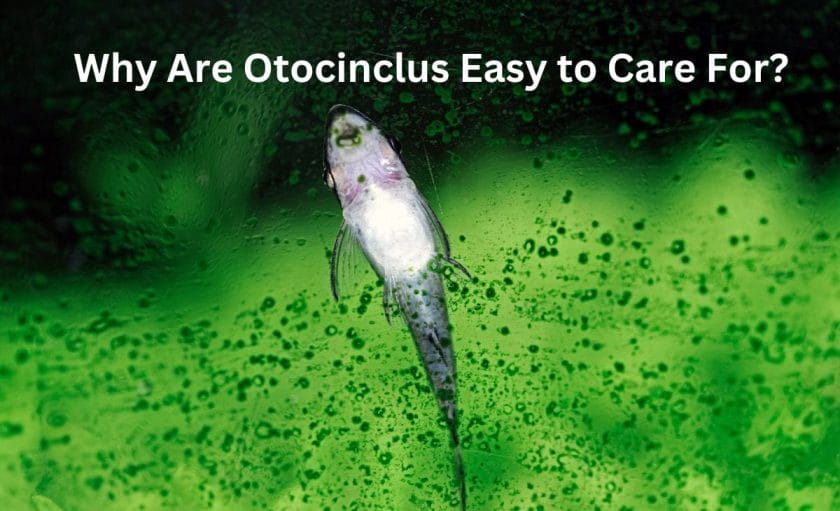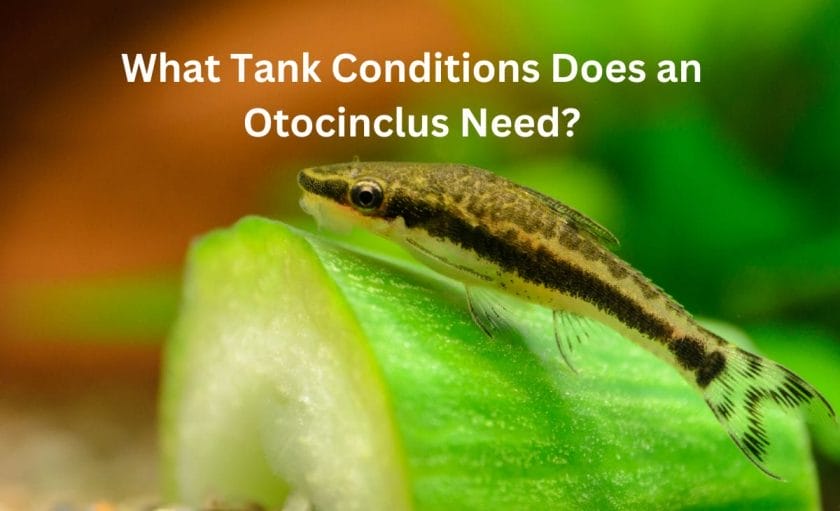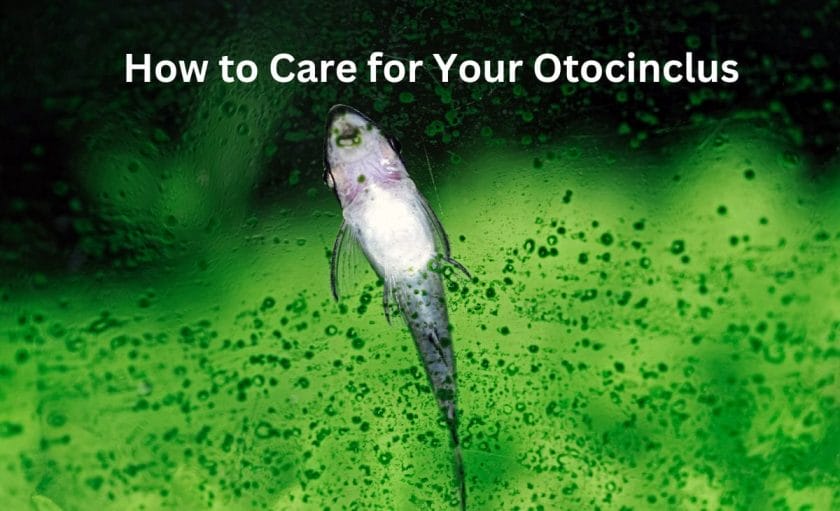Delving into the world of aquarium keeping brings forth a multitude of choices when it comes to selecting the perfect aquatic companions. Among the diverse array of freshwater fish, Otocinclus catfish have earned their place as popular tank inhabitants, known for their algae-eating prowess and unique characteristics. In this blog post, we’ll explore the question on many hobbyists’ minds: Are Otocinclus easy to keep?
Otocinclus are quite easy to care for, capable of thriving in a range of pH, temperature, and water hardness conditions. They do need to be kept in groups and must have a steady supply of algae.
Keeping Otocinclus is straightforward, but as with any fish, you’ll want to understand what the species needs to survive before incorporating them into your tank.
Keep reading, because I’m going to provide a helpful breakdown of the Otocinclus, both the tank parameters you need to keep them and their species-specific instructions.

Table of Contents
Why Are Otocinclus Easy to Care For?

Otocinclus are small and hardy, two important metrics for a beginner fish. They are peaceful and predominantly keep to themselves, although they do shoal and should be kept in groups of 6 or more.
They spend most of their time eating algae, are nonaggressive towards other fish, and don’t contribute heavily to the bioload thanks to their small size. All of these features make the Otocinclus a great beginner fish.
What Tank Conditions Does an Otocinclus Need?

Despite how easy Otocinclus care can be, creating ideal tank conditions for all of your fish is important.
Here’s a helpful table for you to identify what your Otocinclus needs.
| Max Size | 2 inches |
| Diet | Predominantly algae |
| Temperament | Peaceful |
| pH | 6.0-7.5 |
| Temperature | 72-79 F |
| Water Hardness | 15 dgH or less |
| Minimum Tank Size | 10 gallons |
Each one of these parameters is significant. Fish who are exposed to temperatures outside their normal comfort zones, for example, may be more stressed, not only impacting their quality of life but also increasing their risk of illness.
Stocking
It’s also important to consider how your tank is stocked. The more fish are in your tank, the more waste they produce. Small as they may seem, even Otocinclus contribute to the bioload, a measure of the waste a tank produces.
Too much, and the bacteria in your filter will not be able to keep up, allowing harmful conditions to predominate in your tank.
Environment
The tank environment is important for Otocinclus, largely to make sure that they are not preyed upon by other fish. Otocinclus are peaceful and need places to hide.
Plants, driftwood, and other decorations work wonders to provide your Otocinclus a safe environment free from the aggression of other fish.
Diet
While Otocinclus eat predominantly algae, more so than even most other algae eaters, it’s still important to supplement their diet with some veggies.
It’s also worth noting that Otocinclus will not eat some types of algae, namely black beard algae, staghorn algae, hair algae, or other types of hard algae.
Green algae, brown algae, and biofilm are all fair game and an essential part of an Otocinclus’s diet. Of course, if your tank doesn’t have much algae, you can feed your Otocinclus algae wafers.
Just be sure, as is the general rule, to remove any leftover food an hour after feeding time to avoid introducing ammonia to your tank.
Serve these veggies, chopped and blanched, as an occasional treat for your Otocinclus.
- Zucchini
- Cucumber
- Carrots
- Celery
Company
Otocinclus are social fish and enjoy shoaling behavior. Without it, they will be stressed and living in an unnatural environment. Keep at least 3-5 Otocinclus in a 10 gallon tank and 6 or more in a 20 gallon tank. You can, of course, include more, but your tank should be big enough to host them, plus your other community fish.
How to Care for Your Otocinclus

Caring for your Otocinclus is a process of acquisition and monitoring.
First, introduce and acclimate your fish to their new environment. A good understanding of ideal tank parameters with regard to the fish you’re keeping goes a long way to a successful aquarium endeavor.
Purchase Your Tank and Other Aquarium Necessities
Start by purchasing a tank. Ensure it is seamless and has no imperfections (you can leave it full of water overnight to test for leaks. Rinse it out thoroughly. Salt, vinegar, and a hose are all you need. Avoid using dish soap, as even a little residue can be toxic.
You should also carefully rinse your chosen substrate and decorations. Ensure you’ve got all the necessities in your tank:
- An adequately sized filter
- A heater
- An air stone and air pump
- Plants or other decorations
Be sure you cycle your tank before introducing any fish—a process of 4 to 6 weeks. Otocinclus are not good for fish-in cycling. They are too small and too sensitive. Once your tank is cycled, you’re ready to add new fish!
Acclimate Your Fish
Acclimation is important to avoid transfer shock. After traveling, fish are more susceptible to diseases and, of course, stress. To minimize the shock, float your fish in the bag they arrived in on top of the tank for half an hour to an hour. Once you’ve done that, empty the bagged water down the drain (it’s nasty; you don’t want it in your tank), using a net to catch the fish.
Transfer them to your new tank a few at a time and feed sparingly for a week or two. Too many fish or too much food can spike the ammonia in a tank. Within the first few weeks, a newly cycled tank is most susceptible to changes in water parameters.
Of course, if your tank is already cycled and has new fish, then you should use a quarantine tank for your Otocinclus to make sure they aren’t harboring any diseases. The same process holds true for any future fish you introduce.
Monitor Your Tank Conditions
As mentioned, your tank is most susceptible right after cycling. Even if your tank is already cycled, it’s smart to use a test kit every once in a while and dilute the water to reduce the concentration of ammonia.
Careful monitoring is the key to identifying many diseases, parasites, and other harmful conditions in your tank.
FAQs

What Is the Minimum Otocinclus Tank Size?
Otocinclus need at least 10 gallons to thrive, but with more fish, you ideally need to size up your tank to accommodate the waste they will produce. An ideal tank size might be a 20 or 30 gallon tank.
Can You Keep Otocinclus with Guppies?
Otocinclus and guppies get along well. They are comfortable in similar tank conditions, and they harbor no aggression towards one another, as both species are peaceful. Just be mindful of the bioload, and you can house these two species amenably.
Are Otocinclus Better at Cleaning Algae than Plecos?
Otocinclus are widely considered the best algae eater in the aquarium hobby. Size alone might not make them better than a pleco, but their sheer voracity for algae make them a great asset to keep your tank clean.
Conclusion
The Otocinclus is a small, entertaining fish that can help keep your tank clean. They’re quite easy to care for in most regards, capable of thriving in a range of tank conditions.
Hopefully, I’ve given you a good starting point if you’re considering including these algae-eating champs in your tank.
Be sure to pay attention to the useful data in this article, as it contains a helpful table to make sure your tank is ready to house the illustrious Otocinclus!